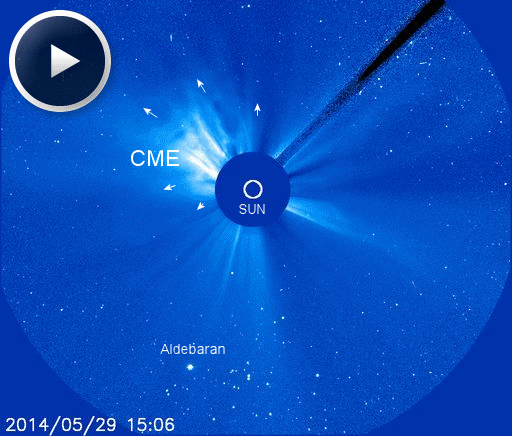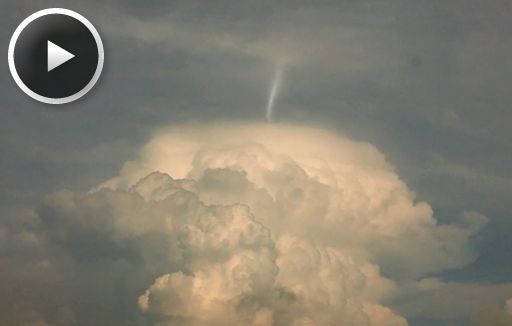Listen to radar echoes from satellites and meteors, live on listener-supported Space Weather Radio. | | | SUNSET SKY SHOW: When the sun goes down tonight, step outside and look west. A beautifully-slender crescent Moon is shining through the twilight not far below the planet Jupiter. It's a nice way to end the day. [photo gallery] FARSIDE EXPLOSION: The Earthside of the sun quiet, and there have been no significant flares for days. However, an uptick in solar activity might be right around the corner. On May 29th, the Solar and Heliospheric Observatory caught a farside CME rocketing over the sun's northeastern limb: 
A shock wave in the leading edge of the CME emitted a strong burst of radio static. An analysis of those signals suggests that the cloud's velocity was approximately 700 km/s or 1.6 million mph. This may sound fast, but it is in fact typical for CMEs. NASA's STEREO probes have pinpointed the blast site: It is just behind the sun's northeastern limb. In two or three days, solar rotation will bring the underlying sunspot into view from Earth. At that time, the Earthside of the sun could become active again. Solar flare alerts: text, voice Realtime Space Weather Photo Gallery CLOUDTOP PHENOMENON: For years, researchers have been studying red sprites and blue jets--strange forms of lightning that come out of the tops of clouds. On May 27th, a new form appeared. Pilot Cherdphong Visarathanonth was in the cockpit of an A320 at the airport in Bangkok, Thailand, when he saw a white tornado-like beam dancing atop this cumulonimbus cloud: 
"We could see the same phenomenon through both windshields even after the aircraft has pushing back in a different direction," says Visarathanonth. "I made a 4 minute video in which we can see the phenomenon quickly moving and disappearing from time to time." Brian Whittaker, another pilot with extensive sky watching experience, says, "I have seen Blue Jets and Sprites, but this is something totally different. Good luck figuring out what it is." One reader suggests that it is a "jumping sundog." Lightning discharges in thunderclouds can temporarily change the electric field above the clouds where charged ice crystals were reflecting sunlight. The new electric field quickly re-orients the geometric crystals to a new orientation that reflects sunlight differently. Videos of the phenomenon show that it might be related to what Visarathanonth saw. Other ideas are welcomed. If you have one, post it in the comments section of Visarathanonth's Space Weather Gallery page. Realtime Space Weather Photo Gallery
Realtime Comet Photo Gallery
Realtime Meteor Photo Gallery
Realtime Aurora Photo Gallery Every night, a network of NASA all-sky cameras scans the skies above the United States for meteoritic fireballs. Automated software maintained by NASA's Meteoroid Environment Office calculates their orbits, velocity, penetration depth in Earth's atmosphere and many other characteristics. Daily results are presented here on Spaceweather.com. On May. 30, 2014, the network reported 7 fireballs.
( 7 sporadics)  In this diagram of the inner solar system, all of the fireball orbits intersect at a single point--Earth. The orbits are color-coded by velocity, from slow (red) to fast (blue). [Larger image] [movies]
Potentially Hazardous Asteroids ( PHAs) are space rocks larger than approximately 100m that can come closer to Earth than 0.05 AU. None of the known PHAs is on a collision course with our planet, although astronomers are finding new ones all the time. On May 30, 2014 there were potentially hazardous asteroids. Notes: LD means "Lunar Distance." 1 LD = 384,401 km, the distance between Earth and the Moon. 1 LD also equals 0.00256 AU. MAG is the visual magnitude of the asteroid on the date of closest approach. | | The official U.S. government space weather bureau | | | The first place to look for information about sundogs, pillars, rainbows and related phenomena. | | | Researchers call it a "Hubble for the sun." SDO is the most advanced solar observatory ever. | | | 3D views of the sun from NASA's Solar and Terrestrial Relations Observatory | | | Realtime and archival images of the Sun from SOHO. | | | from the NOAA Space Environment Center | | | the underlying science of space weather | | 
